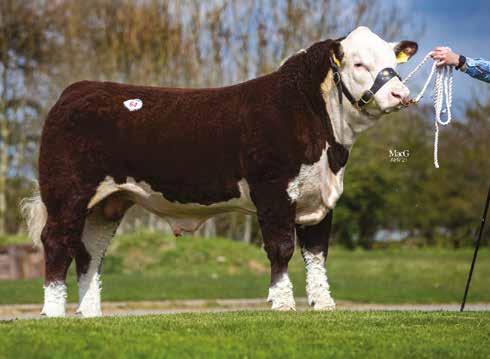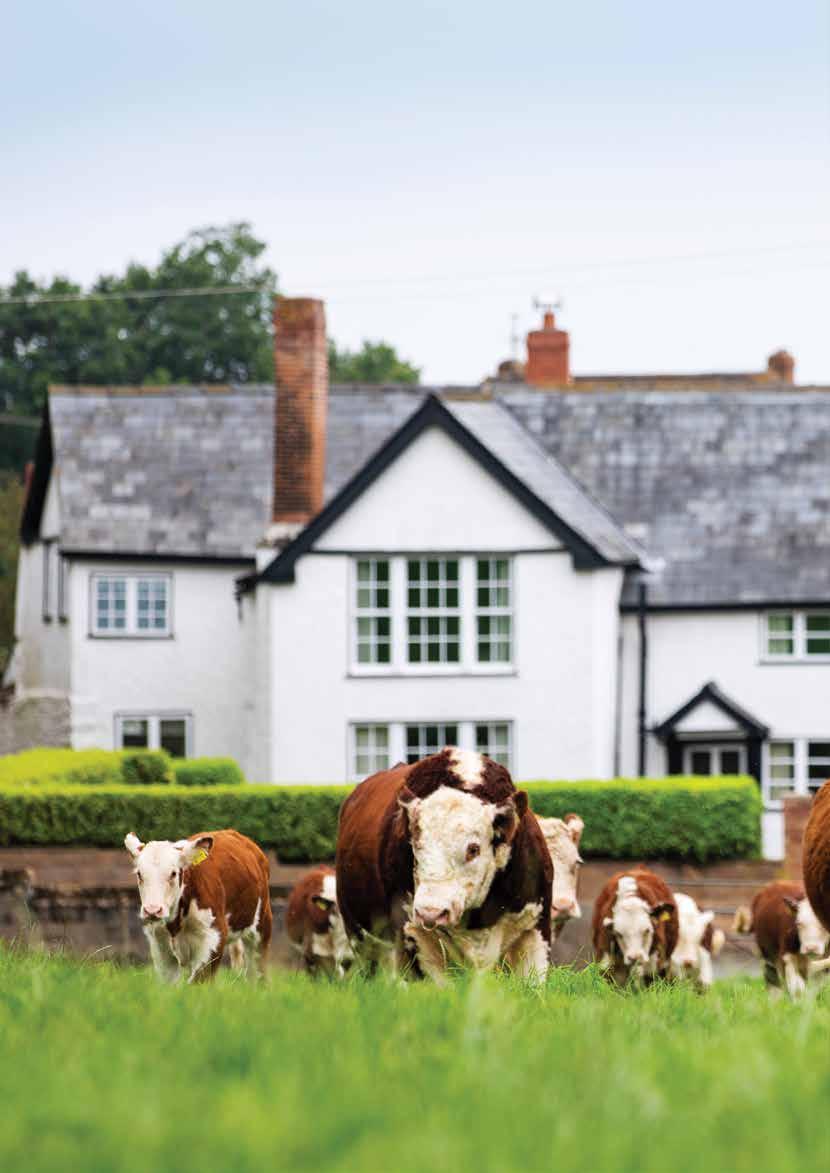
18 minute read
Lewis family celebrates 200 years of breeding
Lewis family celebrates 200 years

The Lewis family has been involved in the Hereford breed for six generations, and in 2022 celebrates a bicentenary of breeding the red and white cattle.
Not many farming families can make claims like these Herefordshire-based breeders: the oldest herd of Herefords in the world to be continuously owned under the same family name; exports to 24 different countries and a heavy influence on the Hereford breed globally. The Lewis’ story starts way back in 1822 when Thomas Lewis founded his herd of Herefords. Before the creation of prefixes or herd names, at this time not even the first volume of the herd book had been published, which followed in 1846.
At the end of the 19th century, the influx of British-bred cattle to the United States of America was gathering pace. In the boom years of the 1880s, a good number of Lewis-bred animals were exported to the USA. Purchased by breeders Gudgell and Simpson in 1881, among these sales were Anxiety 4th from Stocktonbury and Dowager 6th from Thomas Lewis, with the latter the most influential, and together they became the cornerstone of the Hereford breed in the USA.
The policy of Gudgell and Simpson was to line breed their early imports, and their most notable achievement was the breeding of Prince Domino in 1914, regarded as the greatest bull in the early development of the North American Hereford which went back to both Anxiety 4th and Dowager 6th seven times. Prince Domino and its sons appears in pedigrees around the world and also played a part in the creation of the American Line One programme. Thomas’ nephew James (senior) Lewis moved from The Woodhouse in 1888 when he married Margaret Bray, whose grandfather quite fittingly was a nephew of Benjamin Tomkins, regarded as the founder of the Hereford breed.
L-R Ben, Carol, Edward, James, Lucinda and Billy Lewis

On leaving The Woodhouse, a dispersal sale was held, which saw 133 head of Hereford cattle sold.
On relocating though remaining in Herefordshire, they set up home at The Haven, Dilwyn and continued breeding Herefords for the next 40 years. One of the cows which travelled with James from The Woodhouse was Teresa 2nd which founded the Tiny and Thrush families which are still very prominent with the Haven herd today.
The Lewis family were always just traditional Herefordshire farmers, while the likes of dukes and lords were showing at the Royal at that time. One of the most influential bulls purchased during the time James was at the helm was Leyburn from Allen Hughes, Wintercott, Leominster. An outstanding son of this well-regarded bull was Turgot which stood champion at the 1917 Hereford show and sale, selling to Messrs Liebigs of South America for 2,000gns. Adding to the significance of this bull, as son Edward (senior) was away at the First World War, James’ daughter Gwen brought out the bull and was the first lady to ever do so in Hereford Market.
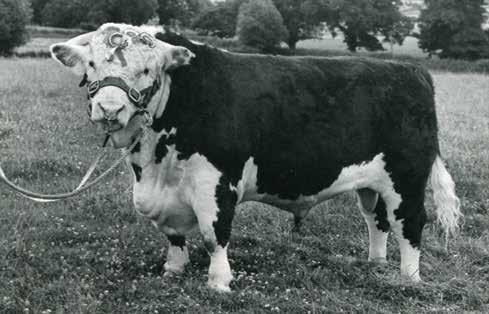
It was roughly at this time that herds, including that of the Lewis family, started putting the herd name before the animal name, making it a prefix. In 1928, as the developed economies of the world lay in depression, Edward (senior) took over The Haven from his father James (senior) when he married. In the first decade of his time in charge, it was a case of survival, while the price of pedigree cattle was at its lowest for over a century. However, Edward (senior) endeavoured to preserve the standard of his herd and managed this by acquiring Free Town Bodyguard in 1946, which moved the herd into the spotlight. At the first February show and sale
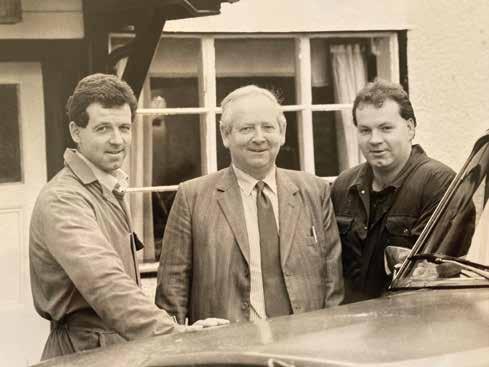
after the Second World War at Hereford Market, Haven Victory, a son of Free Town Bodyguard, sold to Senor Duggan of Argentina for 1,900gns, while another son, Haven Broadside, was the first bull to make 1,000gns at the Hereford April sale, selling to the Duke of Newcastle. At this time Edward (senior) was also fortunate to rent the neighbouring farm, Henwood, from his uncle George Bray, and these additional pastures enabled the herd to double its size in the forthcoming years. In 1949, Edward's (senior) son Leslie and daughter Sybil joined their father to form EL Lewis and son, the name associated with the business at The Haven today. This newly formed partnership’s first purchase was Shucknall Favourite which proved to be one of the best sires within the breed for nearly a decade and progeny was almost unbeatable in the show ring. During this period, The Haven also purchased some top female families, including the Pinky, Prunella and Julia lines from The Vern and Lady Lynda and Martha bloodlines from Tarrington. Leslie had been stricken by polio when in his teens and was the only survivor of 13 admitted to Hereford hospital that week. Since then, he had always walked with a stick, and although not able to do a lot of physical work, he became a master of marketing and built up an export business which no other herd of any breed ever matched, nor probably will. The old established herd of The Haven really hit the forefront at the 1952 Kington Show, a key event within the breed at the time, where they took the grand male and grand female titles with Haven Lion and Haven Crocus, which later combined to produce Haven Postman. The double championship was again taken the following year at Kington, with Haven Cottage Rake and Tiny 16th. Edward (senior) was elected as president of the Hereford Herd Book Society in 1956 and won the first ever herd of the year award in the same year, due to the great influence of Shucknall Favourite.
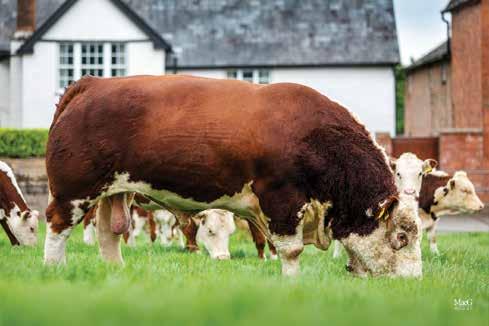
Vron Gaffer followed in the footsteps of this herd sire at The Haven and was a son of Vern Drummer, and again left a mark, breeding many successful animals. Another bull of the year, this was EL Solpoll 1 Lawman is the current herd sire for the Haven herd
Lewis and son’s first Royal supreme champion.
In 1958, Haven Nobility stepped up as senior herd sire and bred three Royal Show victors. Haven Showman took the reserve grand male title at the 1963 Royal and Haven Tommy which won the junior class at the three main shows in 1963 and was purchased by Bar Pipe Ranch, and became a top sire in Canada.
Havenfield Eclipse stood reserve supreme and grand male at the 1964 Royal as well as being bull of the year and then of the decade.
Haven Showman took the Royal Highland Show supreme championship in 1963 before heading up the winning interbreed team, being the first time the Herefords had done so, and has been won only once since. A very noteworthy sire, Showman also sired three successive Royal Show female champions, including female of the year, Havenfield Regina 2nd which stood reserve in the Burke Trophy with Havenfield Eclipse in 1964. Showing his worth even more, by 1970, 63 sons and daughters of Showman had been exported overseas.
Leslie Lewis is admired for the sheer volume of exports achieved at The
Haven Farm facts
• 162 hectares (400 acres) • 55 ha (135ac) cider apples – supplying Bulmers/Heineken,
Westons and Magners • 2.8ha (7ac) Fuggles hops • 40ha (100ac) arable – wheat, barley and oats • 60 pedigree females

Hereford bull sale, Edinburgh, February 1960 - L-R Ted Hewitson, Leslie and Edward Lewis. Credit: The Scottish Farmer
Haven, with 323 live cattle exported to 21 different countries between 1956 and 1976.
Through the sixties, Haven cattle were selling very well, and were all moving through Hereford Market. There had been a healthy level of competition between the herd at The Haven and Captain de Quincey’s Vern herd which dispersed in 1966. In front of a packed ring from all corners of the world following de Quincey’s death, E L Lewis and son purchased Vern Rooti for 12,000gns which went on to sire Avon Priam, a Royal Show champion and 1971 bull of the year. Haven Evolution then took the 1972 bull of the year title, while Haven Frontier won the accolade in 1973.
Success continued through this decade and in 1974, Haven Oyster Girl 36th, grand female champion at the Royal Show, sold for a British record price of 6,500gns to Bert Reyes of San Antonio, USA. The following year, BP Silver Standard Tommy 128G was purchased for $10,000 at the Bar Pipe sale in Alberta, Canada, and was out of a daughter of Haven Tommy, bringing these genetics back home to Herefordshire. BP 55C Britisher 1M was later purchased in 1982 from the same Canadian breeders for $26,500.
A British record price, Free Town Kendal, was purchased by the Lewis family in 1976 for 17,000gns. Between 1976 and 1981, six very successful annual production sales were held at the family’s Boycefield Farm, with 700 pedigree cattle going through the ring, many finding homes in the UK, but a great number were exported. Not only did these sales fuel the success of the Lewis’ herd, but also helped to put the Hereford breed in the limelight.
At the third Haven sale in 1978, opened by TV personality Ted Moult, new breeders paid high figures peaking at 12,000gns for Haven Lumberjack, by Nuelands Giles, purchased by John Leroy from Kent along with six heifers. The second highest price paid was 9,000gns for Haven Nugget, sired by the Canadian bull, BP Tommy 128G. At the same sale, Haven Pearl 2nd broke the female record price at 6,600gns, selling to George Hughes, the owner at Hampton Court, Herefordshire, who that day bought six heifers totalling 19,650gns.
At the following year’s sale, George Hughes again paid a new British record when purchasing Haven Performer for 22,000gns, along with Haven Pirate by BP Tommy for 15,000gns and eight heifers for 15,800gns.
Another record breaker at 1980’s Haven sale was made for Haven Reign On, knocked down at 27,000gns to Jim Cross of Canada who ran the Bar Pipe Ranch, where the Lewis family was a repeat purchaser. This male price record remains in place to this very day.
Boycefield Farm facts
• 121ha (300ac)
• 250-300 North Country Cheviotcross mule ewes
• 28ha (70ac) arable ground • Building up to 40 pedigree Hereford females Lisrace Lumberjack is the herd sire at Boycefield Herefords

Haven Lion, male champion at the 1954 Kington Show
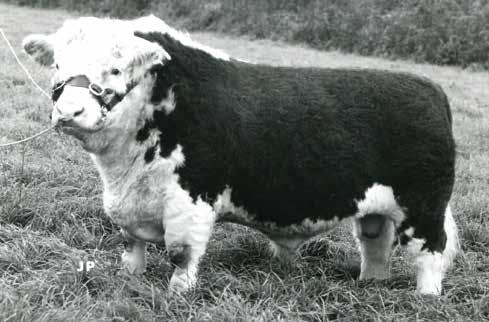
The 1981 Haven sale saw Haven Samson by Hi Standard Brit Lad 26G top the trade at 20,000gns. The Lewis family retained a half share while semen went three ways to B and H Herefords, Canada; RC Atkin, Utah and the Zambian Government Developments. In 1984, at the age of 21, Edward (junior), Leslie’s son, joined the partnership to become the fifth generation of the Lewis family to breed Hereford cattle. He had success in his own name with EBL Haven Tiny which took the grand female championship at the Royal Show in 1984. In the same year, Haven Trafalgar was supreme champion at the National Hereford Show at Tenbury Wells. Such was the recognition of quality of Haven-bred cattle, in 1986 a £10 premium scheme commenced offered by the Somerset-based Mid-West Calf Group for Haven sired calves. In 1987 Haven cattle headed to Germany, making it the 26th country to be exported to. The following year in 1988, a unique written auction took place, to celebrate 100 years at The Haven. Leslie was responsible for the importation of semen of SNS Generator 28X, which became a widely-known bull, and arguably a breed changer, having sired three of the top price bulls at Calgary 1992. The National Show of 1996
saw three top prize winners exhibited from The Haven, all by SNS Generator 28X. Leslie can also be credited for master-minding the National Hereford Show, established in 1983 which has run at Tenbury Show ever since, where now son Edward has stepped up as show organiser, leading on sponsorship. Edward comments: “My father Leslie brought Generator semen into the country which helped move the breed forward and bring it into the modern era. He strived to find the best genetics, and not only did they benefit our cattle at The Haven, but also the wider breed.

Haven cow families
• Dowager • Curly • Lady Lynda • Louisa • Splendour • Prunella • Tiny • Thrush Poll: • Ruby • Lucy • Stardust major supreme championship to be won by the herd since Haven Great Heart at the Three Counties 20 years earlier. Its dam, Haven Patch 73rd, had won the female championship at the Royal Welsh Show the previous year. In 1995, the year which Leslie passed away, Edward and wife Carol moved to The Haven while brother James and his wife Lucinda moved to Boycefield Farm. In 2003, the business split with Edward and Carol continuing the Haven prefix, while James and Lucinda bred under the Boycefield herd name, which had been previously utilised as the Lewis family’s poll herd name. From here on in, Haven champions were being brought out more and more, with the help of stockman Mike Chandler, with the first National Show champion of the 21st century yet another Havenbred bull, this time Haven Smurf, a son of Haven Leopold and grandson of SNS Generator 28X.
“In the 1980s, the whole system went against the breed with cheap grain which suited the production of continental breeds but the circle has come back around and meat quality and flavour along with grass-feeding is playing an increasingly important role.” Haven Joker, a Generator son, took the supreme championship at the 1993 Royal Welsh Show. This was the first Haven Wizard stood champion at the Three Counties Show in 2005, with onlookers noting its similar type to the Haven animals of former years, despite little home-breeding in its pedigree. Now farming in his own name, James
Boycefield cow families
• Curly • Louisa • Pinky • Acorn • Purport
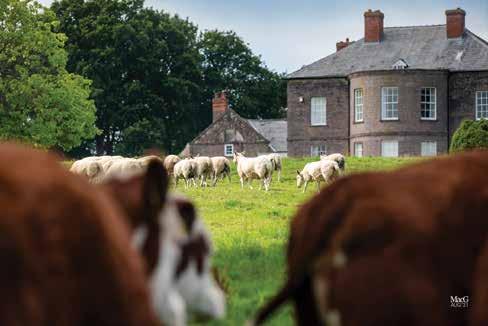
took the reserve overall champion title with Boycefield Congo at Kington Show in 2006. Congo went on to stand reserve male champion at the Royal Show in 2007.
Today, it is thought The Haven is one of the only two true traditional Herefordshire farms still in operation, with a mix of Hereford cattle, cider fruit and hops. The other farm in mind is Sarah Hawkins’ The Farm in Bosbury. Edward explains: “Today the cattle have to fit into our system. They have to be easily managed and cannot take up too much of our time.”
Nowadays, Edward farms with son Ben at The Haven where they keep 70 cows while James works with his son Billy at Boycefield Farm, just up the road, where they run 30 cows and won the 2021 HCBA medium herds competition. With a similar eye for stock, the two herds have recently bought semen from Yarram Park Unique P160 from Australia. Ben visited the Mawarra herd while in Australia following the completion of his degree from Reading University and in 2021 Edward and Ben purchased Mawarra Influential as part of a syndicate alongside PRJ and LR Vincent, Norfolk and Australia’s Graham Genetics for AUD$42,000 out of the Wodonga National Sale, where it was a class winner.
Ben comments: “The cattle at Mawarra are run under a hard selection process, partly due to the environmental conditions. This means it is a good destination for genetics for us as they are proven through performance.”
Edward continues: “Today the Hereford has better live weight gains and maternal characteristics which puts the breed in a great position for the future. Everything about the animals has improved which we see when using old semen which we remember as producing some leading animals but now just doesn’t compare to the breeding of today.”
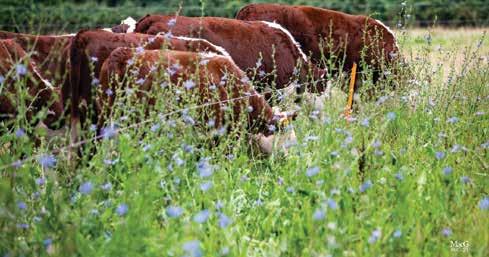
Both Ben and Billy have a keen interest in regenerative agriculture and mob grazing
Although Haven Herefords are regularly spotted in the show ring, Edward says he finds the biggest sense of achievement to be when customers return to The Haven having already purchased stock which has performed well for them. Ben adds: “We find there are cows which stick in our mind more than bulls. The Dowager, Lady Lynda and Splendour lines have been particularly influential for us.”
“We don’t tend to show females as we like them to be at home doing the work,” adds Edward.
“One of the most important shows for us now is the Christmas Calf Show at Shrewsbury Auction Centre. We see it as a barometer of the herd to see where we are, with both the horned and poll strain coming head-to-head. It is a proper national show.
“We have had two male champions at the HCBA Christmas Calf Show: Haven Neptune and Havenfield 1 Robin Hood. We have won the grand male championship at the National Show a total of nine times.”
Although synonymous with horned breeding, some poll animals were acquired by the family in the 1960s, and over the past six or seven years, the poll strain has been reintroduced with 10 cows residing at The Haven, mainly based on Dendor, Romany and Solpoll breeding. Edward says: “Having a number of poll animals gives a choice to buyers and provides us a challenge. At the end of the day, all strains of the breed are Herefords.”
Edward and Ben consider the best poll stock bull they have bought as Solpoll 1 Lawman which was born in 2013 and is a Panmure 1 Henry son. James and Billy also run a flock of sheep and arable ground alongside their herd
At The Haven, 95 per cent of bulls are sold off-farm, and Edward says they like to show purchasers the whole farm and the system they are running. Up the road at Boycefield, James and Billy are working to increase cow numbers, aiming for 40 cows, all of which are horned. Calving takes place both in spring and autumn at an equal split, with the spring calvers getting on with it outside.
James says: “I like an animal with a nice level top, which is kind to the eye and hassle free.”
In recent years herd sires at Boycefield have included the Irish-import Corlismore General 700 and Lisrace Lumberjack 16th, purchased from Northern Ireland’s David Wilson.
James and Billy feed home-grown oats, while their wheat goes for milling. They grow bird feed and legume rich pastures and have 8ha (20 ac) in the mid-tier option of the ELMS scheme.
Both herds register most of their heifer calves and roughly half of their bull calves. All males are kept entire and breeding decisions are made at 15 months. Anything which doesn’t make the grade is finished and sold through ABP at Shrewsbury they both like to keep the pedigree bar high. Largely fuelled by their forward-thinking sons, both brothers have gone down rotational grazing routes with both Ben and Billy keen on pursuing a regenerative farming approach. At Boycefield, Billy says: “The cattle are kept in appropriate groups and moved every 48 hours. The aim is to enter a paddock at 4,000+kgDM/ha covers and come out at around 2,500kgDM/ha. The paddock is then rested for 30 to 50 days before being grazed again.” Ben says: “We like to move the cattle on to higher covers so there is not too much stress. We have over seeded clover, plantain and chicory, with these adding to both protein and mineral levels, as well as creating more resilience in the sward, especially in the drier weather.” Edward says keeping pedigree Herefords makes farming interesting and adds a challenge. He says: “Through attending the World Hereford Conferences and visiting people in the UK and overseas, we have been lucky enough to meet a lot of people in the ‘Hereford family’ and have had a great deal of enjoyment out of the breed.”
Bi-centenary sale
To celebrate the Lewis family’s 200th year of breeding Herefords, Haven and Boycefield Herefords will be holding a sale of heifers on Friday 1 July at The Haven. Jonny Dymond of Halls will be conducting the sale and the family looks forward to welcoming visitors to one of the true homes of the breed.
James concludes: “Both Edward and I find it very satisfying to have our sons working alongside us. Moving forward with Ben and Billy involved in both Haven and Boycefield, we are safe in the knowledge our breeding will continue for the sixth generation.”
The Farm, Bosbury Ledbury, Herefordshire HR8 1NW
Hawkins Farming
hawkins_farming
Office: T: 01531 640405
E: admin@thefarmbosbury.com
Sarah Hawkins T: 078137 96053
E: sarah@thefarmbosbury.com
Young Bulls and Heifers Office: T: 01531 640405
For Sale, Visitors Welcome E: admin@thefarmbosbury.com Sarah Hawkins
T: 078137 96053
E: sarah@thefarmbosbury.com
BioBest HiHealth Herdcare Scheme,
BVD & achieved, Johnes – Level 2

Sold: Bosbury 1 Saurez Young Bulls and Heifers Youngstock for sale, For Sale, Visitors Welcome Visitors welcome
